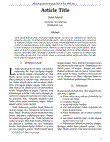Resultados de búsqueda - CHHP~
Materias dentro de su búsqueda.
Materias dentro de su búsqueda.
- Aprendizaje 3
- Strategy 3
- 2
- AI Acceptance 2
- Artificial Intelligence 2
- Artificial inteligence, metaverse, virtual reality, ChatGPT, fiscal law 2
- COVID-19 2
- Caos 2
- Chaos 2
- ChatGPT 2
- Covid-19 2
- Educación 2
- Equifinalidad 2
- Equifinality 2
- Estrategia 2
- Estructura 2
- Inteligencia Artificial 2
- K 2
- K2 2
- K24 2
- Learning 2
- Monterrey 2
- Sistemas 2
- Situacional 2
- Situational 2
- Structure 2
- Synthesis 2
- TIC 2
- Taurine 2
- Teleosts 2
-
661
Rendimiento diagnóstico de la prueba RT-PCR para dengue, zika y chikungunya en orina
Publicado 2019“…Material y Métodos: Se realizó una búsqueda de expedientes a quienes se haya realizado una prueba rt-PCR para DENV, ZIKV; CHKV en suero y orina del 1ero de septiembre del 2016 al 30 de septiembre del 2019. …”
Enlace del recurso
Tesis -
662
Una propuesta metodológica para la evaluación del proceso de enseñanza-aprendizaje en un ambiente virtual (A methodologica proposal to evaluate teaching-learning process in a vi...
Publicado 2007“…This article provides a methodological proposal oriented to optimize the assessment process of a student performance on an on line environment through the application of group communication techniques (advisor-student, student-advisor, studentstudent, student-chat and so on) and widespread use of the new technologies on information and telecommunication as basic tools, based one the process follow-up and statistical data collection from the student´s learning performance and behaviour to enable the construction of significant and reliable indexes thus allowing the advisor a diagnostic on the student´s attitude and performance, allowing him to take on time the adequate preventive/corrective decision measures based on a success/failure tests outputs from the student performance, on a day- to- day basis, on the line environment.Resumen. …”
Enlace del recurso
Artículo -
663
Las organizaciones públicas en responsabilidad con la mujer como grupo vulnerable
Publicado 2016Enlace del recurso
Sección de libro. -
664
Una propuesta metodológica para la evaluación del proceso de enseñanza-aprendizaje en un ambiente virtual
Publicado 2007“…Este artículo ofrece una propuesta metodológica enfocada a optimizar el proceso de evaluación sobre el aprovechamiento del alumno en un entorno en línea mediante técnicas de comunicación grupal (tutor- alumno, alumno-tutor, alumno-alumno, alumno-chat, programa, etc.) y el uso profuso de las nuevas tecnologías de información y telecomunicación como herramientas básicas, mediante un seguimiento y registro estadístico del aprovechamiento y actitudinal del estudiante, posibilitando así la construcción de índicessignificativos, seguros y confiables, que permitan al instructor/facilitador disponer de un diagnóstico sobre el comportamiento y actitud del aplicar y aplicar en consecuencia las medidas preventivas/correctivas sobre la conducta continuamente observada del alumno en el entorno en línea.…”
Enlace del recurso
Artículo -
665
El rectorado de Gregorio Farías Longoria
Publicado 2022“…Alguna ocasión, Roberto Chapa, quien fuera contralor de la UANL, hizo mención de la necesaria valoración de los seis años del periodo de este rector. …”
Enlace del recurso
Artículo -
666
Vasodilator Activity of Compounds Isolated from Plants Used in Mexican Traditional Medicine
Publicado 2018“…Subsequently, involvement of the NO/cyclic guanosine monophosphate (cGMP) and H2S/ATP-sensitive potassium channel (KATP) pathways on the vasodilator activity of these compounds was assessed. …”
Enlace del recurso
Artículo -
667
Global Trends in Aquaculture and Feed Ingredient Use in Compound Aquafeeds
Publicado 2013“…By region, Asia accounted for over 91.2 percent of total global aquaculture production in 2011 (APR 8.46 percent since 1984), followed by the Americas at 3.53 percent (APR 7.59 percent), Europe at 3.20 percent (APR 3.99 percent), Africa at 1.84 percent (APR 14.82 percent), and Oceania at 0.25 percent (APR 9.02 percent).In terms of the major farmed species groups in 2011, finfish accounted for 41.6 million tonnes or 49.8 percent of total global aquaculture production in 2011 (valued at US $ 83.6 billion, with over 102 reported fish species, and production growing at an average APR of 8.85 percent since 1984), followed by aquatic plants at 21.0 million tonnes or 25.1% of total global production (valued at US $ 5.5 billion, with 12 reported aquatic plant species, and production growing at an average APR of 7.16 percent since 1984), molluscs at 14.4 million tonnes or 17.2 percent of total global production (valued at US $ 15.3 billion, with 27 reported mollusk species, and production growing at an average APR of 7.17 percent since 1984), and crustaceans at 5.9 million tonnes or 7.0 percent of total global production (valued at US $ 28.4 billion, with 15 reported crustacean species, and production growing at an average APR 13.1 percent since 1984; FAO, 2013).The total production of the major finfish and crustacean species groups fed industrially compounded or farm-made aquafeeds was reported to be 40.57 million tonnes in 2011 (FAO, 2013), with total global industrial compound aquafeed production estimated at approximately 35.75 million tonnes; the major compound feed fed species groups including: Chinese carp at 11.76 million tonnes (excluding silver carp and big head carp) with an estimated total compound aquafeed requirement of 10.19 million tonnes; Tilapia at 3.96 million tonnes with an estimated total compound aquafeed requirement of 5.79 million tonnes or 16.2 percent of total global compound aquafeed production;Shrimp at 3.93 million tonnes with an estimated total compound feed requirement of 5.54 million tonnes or 15.5 percent of total global compound aquafeed production; Catfish at 3.38 million tonnes with an estimated total compound feed requirement of 3.70 million tonnes or 10.3 percent of total global compound aquafeed production; Marine fish at 2.01 million tonnes with an estimated total compound feed requirement of 2.82 million tonnes or 7.9 percent of total global compound aquafeed production; Other freshwater and diadromous fish at 1.94 million tonnes with an estimated total compound feed requirement of 1.24 million tonnes or 3.5 percent of total global compound aquafeed production; Salmon at 1.93 million tonnes with an estimated total compound feed requirement of 2.51 million tonnes or 7.0 percent of total global compound aquafeed production; Freshwater crustaceans at 1.67 million tonnes with an estimated total compound feed requirement of 1.71 million tonnes or 4.8 percent of total global compound aquafeed production; Milkfish at 891,407 tonnes with an estimated total compound feed requirement of 820,000 tonnes or 2.3 percent of total global compound aquafeed production; Trout at 791,959 tonnes with an estimated total compound feed requirement of 1.03 million tonnes or 2.9 percent of total global compound aquafeed production; Eel at 255,284 tonnes with an estimated total compound feed requirement of 392,000 tonnes or 1.1 percent of total global compound aquafeed production in 2011.In terms of feed ingredient usage, the compound aquafeed sector still remains the largest consumer of fishmeal and fish oil, aquaculture consuming 78 percent of total global fish oil production in 2011 (major aquaculture species group consumer being salmonids at 66 percent followed by marine fish at 17 percent) and 68% of total global fishmeal production in 2011 (major aquaculture species group consumer being crustaceans at 30 percent, followed by salmonids at 22 percent, and marine fish at 21 percent; Dr Andrew Jackson, personal communication, The Marine Ingredients Organization, http://iffo.net). …”
Enlace del recurso
Artículo -
668
Aberration-corrected electron microscopy of nanoparticles
Publicado 2015Enlace del recurso
Sección de libro. -
669
Complex dynamical network control for trajectory tracking using delayed recurrent neural networks
Publicado 2014“…To illustrate the analytic results, we present a tracking simulation of a dynamical network with each node being just one Lorenz’s dynamical system and three identical Chen’s dynamical systems.…”
Enlace del recurso
Artículo -
670
-
671
-
672
Percepciones estudiantiles y retos docentes ante la Inteligencia Artificial Generativa en la Educación Superior
Publicado 2025“…La educación superior atraviesa un proceso de transformación sustancial derivado de la incorporación de herramientas de inteligencia artificial generativa (IAG), como ChatGPT, que han automatizado tareas académicas y de investigación, favoreciendo un acceso más ágil a la información. …”
Enlace del recurso
Artículo -
673
Metabolomic and biodirected phytochemical study of Hechtia glomerata, evaluation of its antibacterial and cytotoxic activity, and determination of the mechanism of action of one ac...
Publicado 2020“…For these reasons it was decided to focus on the CHCl3/MeOH extract, which presented activity against PC3 and was slightly active against MCF7 cell lines. …”
Enlace del recurso
Tesis -
674
Metabolomic and biodirected phytochemical study of Hechtia glomerata, evaluation of its antibacterial and cytotoxic activity, and determination of the mechanism of action of one ac...
Publicado 2020“…For these reasons it was decided to focus on the CHCl3/MeOH extract, which presented activity against PC3 and was slightly active against MCF7 cell lines. …”
Enlace del recurso
Tesis -
675
Structural, microstructural and electrical properties of vitrium-doped barium titanate for multilayer CERAMIC CAPACITORS
Publicado 2018“…This is a noteworthy ferroelectric material because it has a high ferroelectric activity, dielectric constant and spontaneous polarization (Li, Xu, Chu, Fu, & Hao, 2009) and presents a high resistivity (1010–1012 Ω cm) (Belous, V’yunov, Glinchuk, Laguta, & Makovez, 2008). …”
Enlace del recurso
Tesis -
676
Hypothesis test for changes in variance using a statistic based in P-values in a time series of normal independent observations.
Publicado 2015“…The power of the test was simulated using Monte Carlo simulation, and the results were compared with the Chen test (1997) to prove its efficiency. Time series analysts might find the test useful to address homoscedasticity studies were at most one change might be involved.…”
Enlace del recurso
Tesis -
677
Structural, microstructural and electrical properties of vitrium-doped barium titanate for multilayer CERAMIC CAPACITORS
Publicado 2018“…This is a noteworthy ferroelectric material because it has a high ferroelectric activity, dielectric constant and spontaneous polarization (Li, Xu, Chu, Fu, & Hao, 2009) and presents a high resistivity (1010–1012 Ω cm) (Belous, V’yunov, Glinchuk, Laguta, & Makovez, 2008). …”
Enlace del recurso
Tesis -
678
Hypothesis test for changes in variance using a statistic based in P-values in a time series of normal independent observations.
Publicado 2015“…The power of the test was simulated using Monte Carlo simulation, and the results were compared with the Chen test (1997) to prove its efficiency. Time series analysts might find the test useful to address homoscedasticity studies were at most one change might be involved.…”
Enlace del recurso
Tesis -
679
Adaptación a WhatsApp y re-estandarización del trabajo periodístico en Bolivia
Publicado 2022“…Finalmente, la lógica de conectividad detrás de la plataforma de chat móvil pone a los periodistas en una relación de dependencia con la tecnología que precariza su vida laboral y personal. …”
Enlace del recurso
Artículo -
680
La evaluación del alumno en un proceso de enseñanza-aprendizaje en la modalidad virtual.
Publicado 2010“…Este artículo ofrece una propuesta enfocada a optimizar el proceso de evaluación sobre el aprovechamiento del alumno, en un ambiente virtual, mediante el concepto GROUPWARE: (Colaborativo/Cooperativo), técnicas de comunicación grupal (profesor/tutor-alumno, alumno-alumno, alumno-chat, programa, etc.), utilizando las Nuevas tecnologías de Información y las Comunicaciones [NTIC’s], como herramientas básicas, llevando el registro y seguimiento estadístico del aprovechamiento actitudinal del estudiante, posibilitando así, el uso y la construcción de índices significativos, seguros y fiables, que permitan al instructor/facilitador/tutor, gestionar de un diagnóstico, sobre el comportamiento, esfuerzo, dedicación y actitud del aprendiz, obteniendo como resultado la participación integra del alumno en los cursos tomados en la plataforma colaborativa permitiendo en consecuencia las medidas preventivas/correctivas sobre la conducta continuamente observada del alumno en el entorno en línea.…”
Enlace del recurso
Artículo


